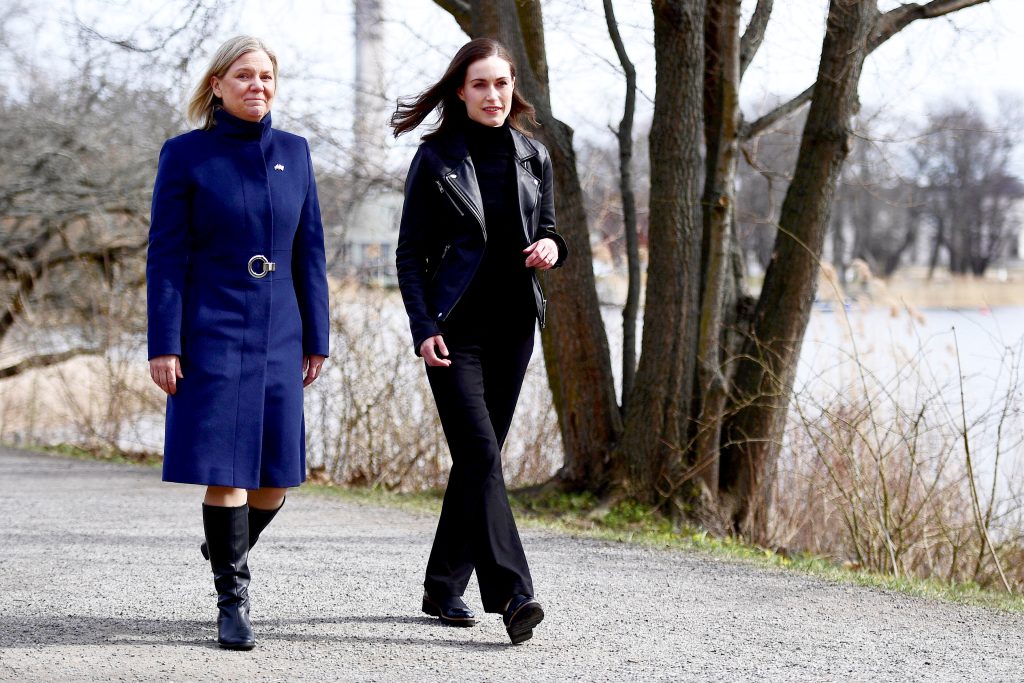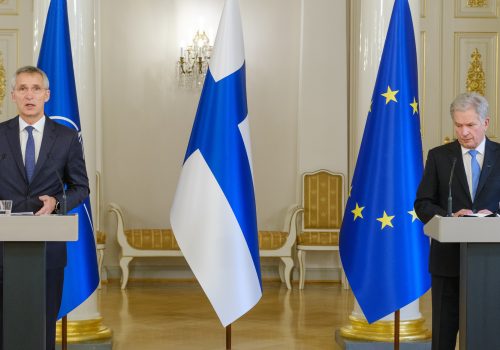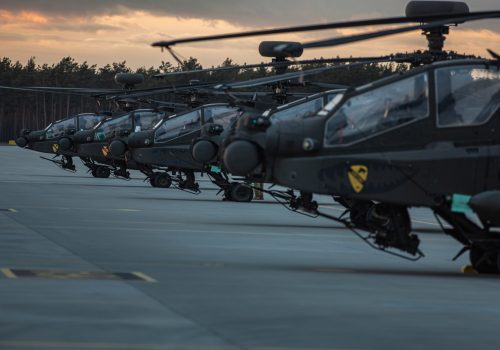
As they watch Russia unleash total war against a European neighbor, Sweden and Finland seem to agree: It’s finally time to join NATO.
With public opinion turning strongly in favor, both countries are inching closer toward formally joining the Alliance. Just this week, their prime ministers publicly telegraphed their strong support for such a move, though Finland appears more certain than Sweden and likely to move first.
But what would that look like? For answers we reached out to Leo Michel, a nonresident senior fellow at the Scowcroft Center’s Transatlantic Security Initiative and the Finnish Institute of International Affairs, who previously served as director of NATO policy at the Pentagon. Check out his responses to our questions below.
What would the process of Finland and Sweden joining NATO actually look like, and how soon could it happen?
Based on past practice, the process would look like this: The governments would formally inform NATO of their desire to join the Alliance, after which the North Atlantic Council (NAC) would need to decide, by consensus, to authorize the NATO secretary general to officially extend an invitation for accession talks. Then, Finnish and Swedish representatives would meet with teams of NATO experts to establish that their country meets the political, legal, and military obligations of NATO membership. After these talks, the aspirants’ foreign ministers would confirm their acceptance of the obligations and commitments in a “letter of intent” to the secretary general. The NAC would formulate (and later approve) a protocol of accession based on consultations with the aspirant—which must then be ratified by each of the thirty allies. Then the aspirants would receive a formal invitation to join, which they would formally approve through their national procedures, and log this with the US State Department.
For the three countries that joined in 1999, this process took about twenty months, and for the seven countries who joined in 2004, about eighteen months. For Finland and Sweden, the accession negotiations presumably would be expedited, but the time required to obtain thirty ratifications from the existing allies is the larger unknown.
How prepared are these two countries to join the Alliance?
Finland and Sweden have modern and capable forces that have been steadily improving in recent years. Both have announced defense spending increases in the wake of Russia’s new invasion of Ukraine, and both have strong democratic institutions and advanced economies.
Despite its relatively small population (5.5 million) and active-duty military, Finland has the largest reserve force in Europe and, in wartime, can mobilize 280,000 troops in thirty days. Unlike many NATO allies (and Sweden at the end of the Cold War), Finland did not significantly reduce its emphasis on territorial defense in favor of expeditionary capabilities abroad. Its decision last year to replace its F-18 combat aircraft with F-35 multirole fighters will make its air force one of Europe’s best. For its part, Sweden—having begun re-emphasizing territorial defense several years ago—has strengthened its littoral, undersea, anti-tank, and air-combat and -defense forces.
Both have developed close relations with the United States and NATO, participating in out-of-area operations (such as in the Balkans and Afghanistan) and Alliance-led exercises. Both have also participated in European Union (EU)-led crisis management and capacity-building operations, notably in Africa, and worked within EU structures to promote a wide range of cooperation with NATO.
Would Finland and Sweden bring any capabilities NATO currently lacks? What about vice versa?
Geography matters: If these two countries were to join, it would strengthen NATO’s deterrence (and, if deterrence failed, its collective defense) across the Arctic, Nordic, and Baltic regions. Beside participating in the information exchanges, command and control networks, and operational planning that are critical elements in a “day zero” response to any threatened aggression, they would also apply their regional expertise on Russia to NATO decision making.
From the viewpoint of Helsinki and Stockholm, the biggest attraction of Alliance membership is certainly the Article 5 (collective defense) commitment. While increasingly committed to building and maintaining strong national-defense capabilities, they realized long ago that “go it alone” strategies won’t work against a determined major-power aggressor. They have also accepted that bilateral defense guarantees from the United States would be sub-optimal and probably impossible to secure anyway.
What would the two countries’ attitudes be toward joining a nuclear-armed alliance?
Although ideological opposition to nuclear weapons appears more prevalent in Sweden, a certain moral opprobrium associated with such weapons has existed in Finland as well. But their approaches have been different. In Sweden’s case, the government (then a coalition of the Social Democratic Party and Green Party) voted in December 2016 for a resolution in the First Committee of the United Nations General Assembly (UNGA) to negotiate a legally binding instrument to prohibit nuclear weapons. In July 2017, Sweden approved the text of the Treaty on the Prohibition of Nuclear Weapons but deferred any decision to sign the treaty. Finland abstained on the UNGA resolution and did not participate in the treaty negotiations.
Given the dramatically changed security situation in Europe due to the new Russian aggression in Ukraine, any lingering Finnish and Swedish concern about joining a declared “nuclear alliance” has notably faded from the public and government discourse—although Russia is trying its best to revive it by threatening to reinforce the Baltic Sea region with nuclear weapons if the two countries join NATO. “In this situation, there could be no more talk of any nuclear-free status for the Baltics—the balance must be restored,” Dmitry Medvedev, deputy chairman of Russia’s security council, said Thursday.
This would amount to the most significant NATO expansion since 2004. How does this moment compare?
It’s the difference between night and day. By 2004, most Europeans and Americans had pretty much forgotten about Russia’s wanton destruction of Grozny, the Chechen capital. Russian President Vladimir Putin had offered cooperation with the West in combatting terrorism, the Russian economy was performing reasonably well, and NATO-Russia relations were mostly stable (if not particularly productive). Moscow wasn’t happy about the enlargement—especially since it included the neighboring Baltic countries—but its reaction certainly wasn’t to threaten military action.
Fast forward to today. NATO allies (as well as Finland and Sweden) watched Russia invade Georgia in 2008, then Crimea and eastern Ukraine in 2014. Then Russia bombed Syria starting in 2015. Putin cites the possibility of Ukrainian membership in NATO as an existential threat that justifies his ongoing brutal war against Ukraine. Unprecedented Western economic sanctions are in place against Russia, and any symbols of NATO-Russian dialogue are distant memories—replaced by the deployment of combat-ready NATO reinforcements along the Alliance’s eastern flank and the regular supply of military equipment by member states to the embattled Ukrainians. The stakes are simply much higher.
Some worry about NATO expansion “provoking” Russia. Is this a real risk for the Alliance?
True, the US intelligence community reportedly warned then President George W. Bush that a 2008 promise to bring Ukraine and Georgia into NATO wouldn’t go down well with Putin. But much of what he’s done since then suggests that, in terms of an existential threat to his rule, he’s more afraid of a democratizing neighbor rather than strictly its membership in a military alliance (which has long been unrealistic anyway). It would be a serious decision, of course, to extend NATO’s defense guarantees to one or both of these countries. But the potential Finnish and Swedish contributions to deterrence and collective defense shouldn’t be underestimated, either. To deny their application, if it passes muster, in the furtive hope of dodging some further Russian outrage against transatlantic security and stability would appear to be a far riskier choice.
Further reading
Thu, Mar 3, 2022
Will Finland and Sweden join NATO now?
New Atlanticist By Anna Wieslander, Christopher Skaluba
Russia's invasion of Ukraine has shifted the political dynamics in the two militarily non-aligned Nordic states. Here's how a fast-track NATO process could look.
Fri, Mar 4, 2022
Europe’s security architecture, transformed: Why Finland is now on a path to join NATO
Issue Brief By Rasmus Hindrén
Finland is now on a prudent approach to NATO membership that is likely to build on its post-Cold War approach of continuity yet also to adapt to a new European security environment.
Wed, Mar 9, 2022
Defending every inch of NATO territory: Force posture options for strengthening deterrence in Europe
Issue Brief By
Deterrence in Europe can be enhanced through a range of US and NATO force posture enhancements.
Image: Sweden's Prime Minister Magdalena Andersson walks with Finland's Prime Minister Sanna Marin prior to a meeting, amid Russia's invasion of Ukraine, in Stockholm, Sweden, on April 13, 2022. (Photo by Paul Wennerholm/TT News Agency/via Reuters.)



